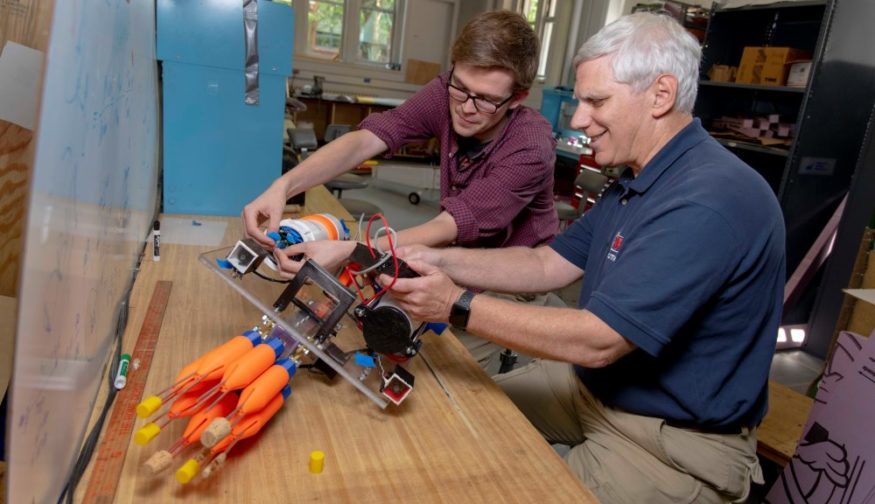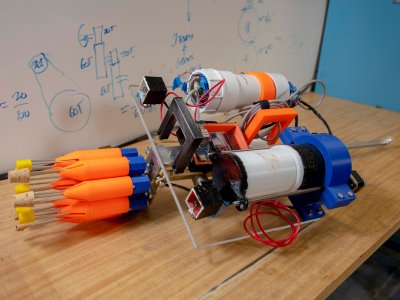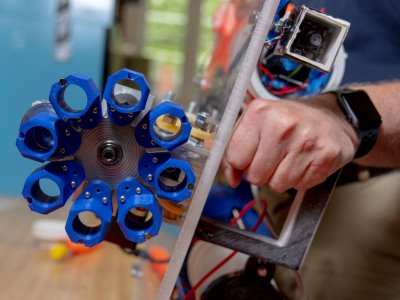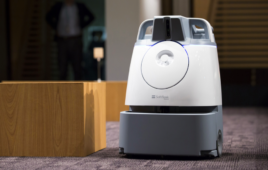
William Godsey ’18, left, and Bradley Miller, associate director of WPI’s Robotics Resource Center, examine the lionfish harvesting robot built by Godsey and his project team. The robot is designed to help reduce the harm caused by an invasive species.
If asked to name an oceanic apex predator, sharks are usually the first to come to people’s minds. But ask a fisherman or conservationist in the Carribean or coastal U.S. and you might get a different answer. There, a much smaller creature is terrorizing the underwater ecosystem.
Lionfish, a colorful aquarium fish native to the South Pacific and Indian oceans, have become a serious problem in the Caribbean and western Atlantic. The National Oceanic and Atmospheric Administration (NOAA) calls them the “poster child for invasive species.” With no predators outside of their native waters, the population is expanding at an astonishing rate, putting additional stress on coral reefs already struggling from the effects of climate change, pollution, and overfishing.
That’s why undergraduate students at Worcester Polytechnic Institute (WPI) are building an autonomous underwater robot that could help reduce the threat posed by an invasive species. The lionfish, if unchecked by natural predators, threatens the well-being of coral reefs and other marine ecosystems in Coastal U.S. and Caribbean waters, including commercially and recreationally crucial native fish the region depends on.
In a multi-year effort launched last fall, WPI student teams are developing a robot designed to autonomously hunt and harvest lionfish. The project’s goal is to reduce the impact of the invasive species on marine ecosystems from the Caribbean up to the coasts of Florida and Georgia. Since the fish is a pricey delicacy, the robot also could provide a new source of income for local fishers.

The robot has eight orange spear tips mounted on the blue carousel, two small boxes just behind the carousel containing cameras, the electronics chamber behind the right camera, and the buoyancy chamber behind the left camera. (Credit: WPI)
The first student project team, completing its MQP (Major Qualifying Project), worked this past academic year to develop several systems that will enable the submersible robot to distinguish lionfish from other species and spear them. The robot could offer local fishers, who frequently scuba dive to spear their catch, a more efficient and safe way to harvest the fish, which have poisonous spines.
“There are economic and environmental benefits to this, and the fish are delicious,” said Brandon Kelly, a robotics engineering student who focused on the robot’s computer vision system. “I’ve seen the massive devastation caused by these fish, and it made me want to work on this project. We felt like we could create some change in the world.”
Lionfish also are disrupting native fish populations that are commercially, recreationally, and ecologically important to the region. According to the Ocean Support Foundation, the fish, which have stomachs that can expand up to 30 times its normal volume as they eat, can reduce juvenile fish populations on a reef by nearly 90% in as little as five weeks. Lionfish have been found with more 50 species of juvenile fish in their stomachs.
WPI joins the fight
WPI students aren’t the only ones trying to curb the lionfish’s destructive appetite either. iRobot CEO Colin Angle and Science from Scientists founder Erika Angle created the non-profit Robots in Service of the Environment (RSE) in the Spring of 2017. RSE’s first device was its Guardian LF1Robot. Essentially a submersible lionfish vacuum, the Kickstarter-funded Guardian robot stuns lionfish before sucking them into a chamber for extraction.
Autonomous lionfish hunting
While the Guardian can be used to harvest lionfish, it needs to be directed by an operator connected to the robot by a tether, which could damage fragile reefs. WPI’s robot would be untethered and would hunt for fish on its own, without human direction. Once it recognizes a lionfish, it would change course to intercept it and spear it. The buoyant spear tip would detach and float the fish to the surface to be collected. A fisher could use multiple robots to maximize his catch.
WPI states the goal is to toss the robot out of the boat, have it go down to the reef, plot out a course, and begin its search. Ideally, the robot will set up a search pattern and fly along the reef without collision. The idea is that the robots could be part of the environmental solution.

A close-up of the carousel that moves the spear tips
into position to be thrust into lionfish by a metal shaft.
One of the robot’s cameras can be seen in the small
watertight box at left. (Credit: WPI)
The past year’s MQP team members used machine learning, advanced computer vision libraries, neural network software, and computer vision models to develop the robot’s computer vision system, which is the key to distinguishing lionfish from the other fish and aquatic species in the area. They showed the system thousands of images of lionfish of different colors, taken from different angles and under different lighting conditions, to train it to recognize a lionfish with greater than 95% accuracy.
The team also developed a spearing and buoyancy compensation system. The robot has a revolving carousel, not unlike the cylinder of a revolver, that holds eight detachable spear tips. A motorized mechanism connects to a metal shaft that thrusts the spear tips into the fish. As the shaft retracts, leaving the buoyant spear tip embedded in the fish, the carousel turns to move the next spear tip into position.
As the spear tips are used, the robot loses buoyancy. To compensate, the researchers built a watertight, air-filled chamber that enlarges slightly after each spearing to displace more water and equalize the robot’s buoyancy.
The team also designed a water-tight chamber to protect the robot’s motherboard and electronics from the salt water, which is highly corrosive. “In many ways, this was the hardest part of the project,” said William Godsey, who worked on the system’s buoyancy and electronics chambers, along with its shooting mechanism. “Just because something is waterproof doesn’t mean it will work in salt water, which is an incredibly corrosive substance.”
The robot is being designed to attach to a commercially available, autonomous submersible robot. During the 2018-19 academic year, a second MQP team will focus on the robot’s global navigation system, which will enable it to autonomously establish and navigate a three-dimensional search grid as it seeks lionfish.
Filed Under: The Robot Report, Robotics • robotic grippers • end effectors





The future of fishing and what better way to start than with Lionfish. We need to get away from big to huge fishing boats that have to rape the sea just to make costs.
Instead a small 1-2 person with an RE powered boat using solar, wind can catch 50lbs and make money.
Vs a diesel 5 man fishing boat has to catch 10k lbs just to break even.
I should mention sitting out fishing a catamaran is far more comfortable, efficient at far less cost.
With robotics and as in this one, remote control you only catch the target fish and not catch, kill so much you can’t eve sell, is a great business plan for many fisherpeople..
Very clever, though the unintended consequence could be that a large grouper ears that lion fish, spear tip and all, as it floats to the surface.
There is incorrect information in this article. The spines are not poisonous. The spines are venomous. There is a difference.